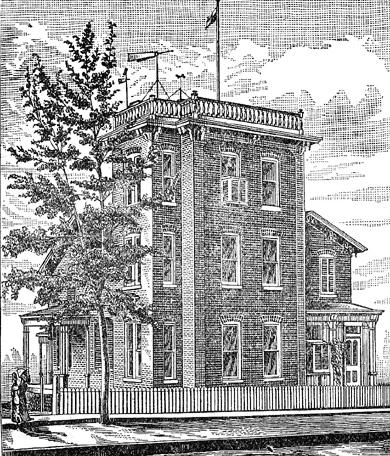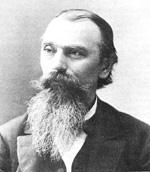|
Prof. Hinrichs was considered an
authority in physics, chemistry and mineralogy. He sufficiently impressed a
fiscally-
conservative rural-oriented Iowa legislature that it funded
construction of North Hall to house his classes and
laboratories. The
61-by-90-foot building was completed in 1866 just 70 feet from Old Capitol. Its third level served
as a combined chapel and library, while Hinrichs
occupied the basement and main levels. In his 1988 history of UI,
John Gerber
reports that Hinrichs' rules for what the student newspaper the University Reporter termed his "temple
of science" were: "Be Quiet, Be
Careful, Be Certain."
Hinrichs developed a national reputation with the
North Hall design and its state-of-the-art laboratories where he
expected students to examine specimens for what they could teach. This came during an
age where most teaching
was done verbally with little "hands on"
experience for students. His interests were broad and varied, including
weather. He established the Iowa weather reporting service in 1875 from his
home on the southeast corner of
Capitol and Market streets, just a little more
than a block north of his workplace on Pentacrest. He remained a
highly influential force on the UI faculty until he was fired in March
1886 after fits of paranoia resulted in verbal attacks
on virtually every other UI leader
and the governing board.
As a former faculty member, his contrived written
attacks continued through much of the rest of his long life which
ended in 1923. Hinrichs, along with UI faculty member and interim president Nathan
Leonard (1832-1917) who
taught mathematics and astronomy, formed a
first-generation core faculty in the sciences which helped foment
subsequent
formation of the medical department in 1870, dentistry in 1882, pharmacy in
1885 and nursing in 1894.
Together with law, engineering and business, these
colleges now graduate more professionals than many larger
state universities,
including giant Michigan which hired away former UI president Mary Sue Coleman
a year ago.
Hinrichs replaced Theodore Parvin (1817-1901) who had ineptly
attempted to establish a science program at UI,
but suffered the handicap of
legal as opposed to science training and eventually taught history. Parvin,
who journeyed to Iowa with newly-appointed territorial governor Robert Lucas,
was dismissed from UI in 1870. Parvin kept detailed journals through his long
life which provide many useful insights to events despite seeming highly
self-serving in viewpoint. He was neither admired nor respected by colleagues,
who described him as vain, arrogant and mischievous.
Hinrichs and Leonard were
succeeded at UI by such second-generation science giants as botanist and
"man-of-all-seasons" Thomas Macbride (1848-1934), geologist and
distinguished scholar Samuel Calvin (1840-1912), as well as
botanist and engineer Bohumil Shimek (1861-1937). The next
generation giants included psychologist Carl Seashore (1866-1949)
and physician Arthur Steindler (1878-1959). But, these
world-class scientists represent only the right hemisphere of
historic superstars at UI.
The left portion of UI's cerebral
cortex is occupied by the likes of Grant Wood, Edward Mabie, Philip Clapp,
Frank Luther Mott, Paul Engle and others who have earned the national
limelight for UI as a distinguished teacher of
fine arts. All these University of Iowa faculty members have
left lasting marks on their chosen professions. Of
course, they were assisted along the way by some first-rate
administrators and able support staffs. As a team, they
have built a reputation for UI which former president Bill
Clinton recently described to a Carver-Hawkeye Arena audience of
15,000 as a "world class university."
Next
Saturday: Retrieving "The Little Dutch Hall" from visual obscurity.
Bob Hibbs
collects local postcards and researches history related to them.
Return
to Postcards Index
|


